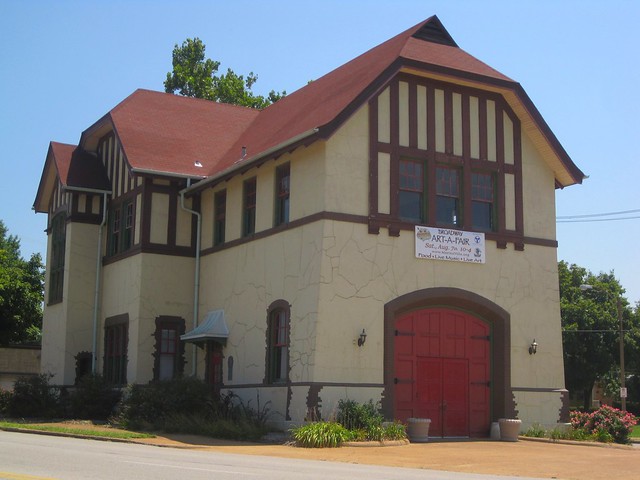by Michael R. Allen
Thanks to the Marine Villa Neighborhood Association, the venerable Fire Engine House Number 3 on South Broadway was open to the public this past Saturday during the lively Broadway Art-A-Fair. The fire station sits on a flatiron block bounded by Broadway, Miami and Salena streets, making it a visual fulcrum in the neighborhood.

The Bavarian-influenced fire house was built in 1918 and operated as an engine house until 1968. Alderman Craig Schmid (D-20th, then D-10th) used ward capital improvement funds to renovate the building in 2001, and it is now leased to an individual user. It is rarely open to the public.

The interior is remarkably intact, with bakery brick walls, concrete floor, historic light fixtures and tin ceiling in excellent condition. The bright red paint on the doors and ceilings is a nice touch. Unconfirmed legend enshrined on a building plaque holds that the gleaming white bakery bricks used inside were left over from the construction of buildings at the Anheuser-Busch brewery, not far up Broadway. Bakery brick manufactured by local makers, chiefly the Hydraulic Press Brick Company, was widely used for interiors of industrial and garage buildings by 1918. Many buildings also used bakery brick for exterior accents or wall cladding as well.

Not knowing much about the history of Fire Engine House Number 3, I sought out Mike Seemiller at the Board of Public Service early this week and he showed me drawings for the building. Drawings dated April 1918 and signed by E.R. Kinsey, President of the Board of Public Service and L.R. Bowen, Engineer of Bridges and Buildings show that the fire station’s current appearance is almost exactly as it was built. The drawings also show that the building is the work of staff designers at the Board of Public Service. The building’s Bavarian style is similar to that of Bavarian and Tudor Revival tavern buildings built by Anheuser-Busch in the teens, including the Stork Inn (1910), Gretchen Inn (1913) and Bevo Mill (1917). All of these were designed by the firm Klipstein & Rathmann, leading some historians to suspect that the fire station was also the work of the firm. The Stork Inn occupies a similar flatiron-shaped block, bounded by Virginia, Idaho and Taft streets. However, the architectural drawings for Fire Engine Station Number 3 show that its beautiful, picturesque design is the work of lesser-known public servants.

One reply on “Fire Engine House No. 3”
I am so happy that this building has been preserved in its original form. My father, born in 1904, lived directly across Broadway in the corner 2nd floor walkup, and many times we passed these locations and he would reminisce on seeing four white horses pull out the smoking fire truck on the way to a fire. I want my daughter to see these buildings in memory of her grandfather.
Keith Eckrich
Albuquerque, NM